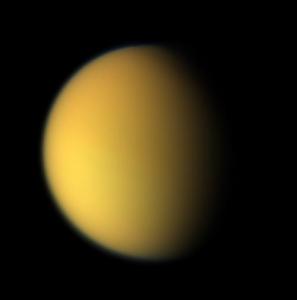Titan continues to live up to its billing as a model of the early Earth. Recent observations by Cassini tell us much about the moon’s atmosphere, about 98 percent nitrogen (with most of the remainder being methane), and laden with organic molecules. Sunlight appears to break these molecules apart as they rise in the atmosphere, where their fragments form heavier organic molecules — propane, ethane, acetylene, hydrogen cyanide. Cold air over the winter pole then causes this material to sink, with the result that heavy organics build up in the stratosphere over the course of the winter.
 Supplying the data is Cassini’s Composite Infrared Spectrometer instrument (CIRS); a paper on its findings is scheduled to appear in the May 13 issue of Science. The polar vortex phenomenon is similar to what occurs on Earth; strong winds circulating around Titan’s north pole isolate the atmosphere over the pole during the polar night, inhibiting mixing with the lower regions of the atmosphere. Something similar happens over Antarctica, leading to the infamous ‘ozone hole’ over the region. There, spring sunlight decomposes molecular chlorine that formed during the winter. Titan has no ozone, but the isolation of the polar atmosphere during the winter night may lead to unusual and complex chemistry.
Supplying the data is Cassini’s Composite Infrared Spectrometer instrument (CIRS); a paper on its findings is scheduled to appear in the May 13 issue of Science. The polar vortex phenomenon is similar to what occurs on Earth; strong winds circulating around Titan’s north pole isolate the atmosphere over the pole during the polar night, inhibiting mixing with the lower regions of the atmosphere. Something similar happens over Antarctica, leading to the infamous ‘ozone hole’ over the region. There, spring sunlight decomposes molecular chlorine that formed during the winter. Titan has no ozone, but the isolation of the polar atmosphere during the winter night may lead to unusual and complex chemistry.
Image: This natural color composite shows approximately what Titan would look like to the human eye: a hazy orange globe surrounded by a tenuous, bluish haze. The orange color is due to the hydrocarbon particles which make up Titan’s atmospheric haze. The image comes from the April 16, 2005 Cassini flyby. Credit: NASA/JPL/Space Science Institute.
“We don’t know if there are even more similarities to Earth’s ozone hole process, like polar clouds that react with molecules in the atmosphere, simply because we haven’t seen them yet,” said Dr. Michael Flasar, principal investigator for the CIRS instrument at Goddard Space Flight Center. “But we wouldn’t be surprised to discover them, nor would we be surprised to find that Titan has some unique twists of its own. This is what makes science so exciting. Nature is too rich for us to predict exactly what we will find when we go exploring.”
Note that Titan’s axis of rotation, like Earth’s, is tilted, setting up the long winter night. But on Titan, polar winter is years long. The moon’s northern hemisphere is currently in early winter. By studying the temperature differences between the north pole and the equator, the team was able to derive the speed of winds around the pole, while CIRS data show that the concentration of several heavy organic compounds peaks in the region. These molecules are the cause of Titan’s now famous orange haze.
A NASA feature story on Titan’s atmosphere can be found here. Also see this news release from Lawrence Livermore National Laboratory.

